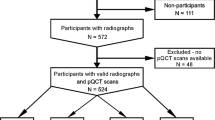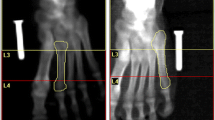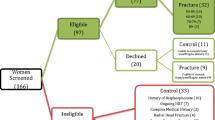Abstract
This prospective study assessed whether metacarpal indices predict fracture risk in children and adolescents. Radiogrammetry was performed at the second metacarpal midshaft on annual hand–wrist radiographs of 359 South African (SA) children aged 10–17 years. Bone length, bone width, and medullary width were measured, and the following proxies for bone strength calculated: metacarpal index (MCI), bone mineral density (BMD), section modulus (SM), stress–strain index (SSI), and slenderness index (SLI). Height and weight were measured annually. Self-reported physical activity (PA) and fracture history were obtained at ages 15 years (for the preceding 12 months) and 17 years, respectively. At 17 years, 82 (23%) participants (black, 16%; white, 42%; p < 0.001) reported a previous fracture. None of the bone measures or indices were associated with fracture in black participants. In white females, after adjusting for PA, a 1 standard deviation (SD) greater SLI doubled the fracture risk [odds ratio (OR) 2.08; 95% confidence interval (CI) 1.08, 3.98]. In white males, a 1 SD greater BMD was associated with a 2.62-fold increase in fracture risk (OR 3.62; 95% CI 1.22, 10.75), whilst a 1 SD greater SM (OR 2.29; 95% CI 1.07, 4.89) and SSI (OR 2.23; 95% CI 1.11, 4.47) were associated with a more than twofold increase in fracture risk, after height, and PA adjustment. No single index consistently predicted fracture across the four groups possibly due to ethnic and sex differences in bone geometry, muscle mass, and skeletal loading. Metacarpal radiogrammetry did not reliably predict fracture in SA children.


Similar content being viewed by others
References
Hedstrom EM, Svensson O, Bergstrom U, Michno P (2010) Epidemiology of fractures in children and adolescents. Acta Orthop 81:148–153
Clark EM (2014) The epidemiology of fractures in otherwise healthy children. Curr Osteoporos Rep 12:272–278
Thandrayen K, Norris SA, Pettifor JM (2009) Fracture rates in urban South African children of different ethnic origins: the Birth to Twenty cohort. Osteoporos Int 20:47–52
Cooper C, Dennison EM, Leufkens HG, Bishop N, van Staa TP (2004) Epidemiology of childhood fractures in Britain: a study using the general practice research database. J Bone Miner Res 19:1976–1981
Jones IE, Williams SM, Dow N, Goulding A (2002) How many children remain fracture-free during growth? A longitudinal study of children and adolescents participating in the Dunedin Multidisciplinary Health and Development Study. Osteoporos Int 13:990–995
Cooper C, Eriksson JG, Forsen T, Osmond C, Tuomilehto J, Barker DJ (2001) Maternal height, childhood growth and risk of hip fracture in later life: a longitudinal study. Osteoporos Int 12:623–629
Foley S, Quinn S, Jones G (2009) Tracking of bone mass from childhood to adolescence and factors that predict deviation from tracking. Bone 44:752–757
Baxter-Jones AD, Faulkner RA, Forwood MR, Mirwald RL, Bailey DA (2011) Bone mineral accrual from 8 to 30 years of age: an estimation of peak bone mass. J Bone Miner Res 26:1729–1739
Amin S, Melton LJ, Achenbach SJ, Atkinson EJ, Dekutoski MB, Kirmani S, Fischer PR, Khosla S (2013) A distal forearm fracture in childhood is associated with an increased risk for future fragility fractures in adult men, but not women. J Bone Miner Res 28:1751–1759
Farr JN, Khosla S, Achenbach SJ, Atkinson EJ, Kirmani S, McCready LK, Melton III LJ, Amin S (2014) Diminished bone strength is observed in adult women and men who sustained a mild trauma distal forearm fracture during childhood. J Bone Miner Res 29:2193–2202
Jepsen KJ (2011) Functional interactions among morphologic and tissue quality traits define bone quality. Clin Orthop Relat Res 469:2150–2159
Wren TA, Shepherd JA, Kalkwarf HJ, Zemel BS, Lappe JM, Oberfield S, Dorey FJ, Winer KK, Gilsanz V (2012) Racial disparity in fracture risk between white and nonwhite children in the United States. J Pediatr 161:1035–1040
Thandrayen K, Norris SA, Micklesfield LK, Pettifor JM (2011) Heterogeneity of fracture pathogenesis in urban South African children: the Birth to Twenty cohort. J Bone Miner Res 26:2834–2842
Mayranpaa MK, Makitie O, Kallio PE (2010) Decreasing incidence and changing pattern of childhood fractures: a population-based study. J Bone Miner Res 25:2752–2759
Clark EM, Ness AR, Tobias JH (2008) Vigorous physical activity increases fracture risk in children irrespective of bone mass: a prospective study of the independent risk factors for fractures in healthy children. J Bone Miner Res 23:1012–1022
Kiel DP, Hannan MT, Broe KE, Felson DT, Cupples LA (2001) Can metacarpal cortical area predict the occurrence of hip fracture in women and men over 3 decades of follow-up? Results from the Framingham Osteoporosis Study. J Bone Miner Res 16:2260–2266
Haara M, Heliovaara M, Impivaara O, Arokoski JP, Manninen P, Knekt P, Karkkainen A, Reunanen A, Aromaa A, Kroger H (2006) Low metacarpal index predicts hip fracture: a prospective population study of 3,561 subjects with 15 years of follow-up. Acta Orthop 77:9–14
Renz DM, Malich A, Ulrich A, Pfeil A, Mentzel HJ, Streitparth F, Maurer MH, Teichgraber UK, Bottcher J (2016) Reference values for digital X-ray radiogrammetry parameters in children and adolescents in comparison to estimates in patients with distal radius fractures. J Bone Miner Metab 34:55–64
Ma D, Jones G (2003) The association between bone mineral density, metacarpal morphometry, and upper limb fractures in children: a population-based case–control study. J Clin Endocrinol Metab 88:1486–1491
Jones G, Boon P (2008) Which bone mass measures discriminate adolescents who have fractured from those who have not? Osteoporos Int 19:251–255
Magan A, Nyati LH, Micklesfield LK, Norris SA, Pettifor JM (2017) Metacarpal growth during adolescence in a longitudinal South African cohort. J Bone Miner Res 32:1926–1934
May A, Pettifor JM, Norris SA, Ramsay M, Lombard Z (2013) Genetic factors influencing bone mineral content in a black South African population. J Bone Miner Metab 31:708–716
Tanner JM (2001) Assessment of skeletal maturity and prediction of adult height (TW3 method). W.B. Saunders, London
Dequeker J (1976) Quantitative radiology: radiogrammetry of cortical bone. Br J Radiol 49:912–920
Jorgensen JT, Andersen PB, Rosholm A, Bjarnason NH (2000) Digital X-ray radiogrammetry: a new appendicular bone densitometric method with high precision. Clin Physiol 20:330–335
Franklyn M, Oakes B, Field B, Wells P, Morgan D (2008) Section modulus is the optimum geometric predictor for stress fractures and medial tibial stress syndrome in both male and female athletes. Am J Sports Med 36:1179–1189
Tommasini SM, Nasser P, Schaffler MB, Jepsen KJ (2005) Relationship between bone morphology and bone quality in male tibias: implications for stress fracture risk. J Bone Miner Res 20:1372–1380
Cointry GR, Ferretti JL, Reina PS, Nocciolino LM, Rittweger J, Capozza RF (2014) The pQCT ‘Bone Strength Indices’ (BSIs, SSI). Relative mechanical impact and diagnostic value of the indicators of bone tissue and design quality employed in their calculation in healthy men and pre- and post-menopausal women. J Musculoskelet Neuronal Interact 14:29–40
Vidulich L, Norris SA, Cameron N, Pettifor JM (2006) Differences in bone size and bone mass between black and white 10-year-old South African children. Osteoporos Int 17:433–440
Manias K, McCabe D, Bishop N (2006) Fractures and recurrent fractures in children; varying effects of environmental factors as well as bone size and mass. Bone 39:652–657
McVeigh JA, Norris SA (2012) Criterion validity and test–retest reliability of a physical activity questionnaire in South African primary school-aged children. S Afr J Sports Med 24:43–48
Solomon L (1968) Osteoporosis and fracture of the femoral neck in the South African Bantu. J Bone Jt Surg Br 50:2–13
Solomon L (1979) Bone density in ageing Caucasian and African populations. Lancet 2:1326–1330
Taes Y, Lapauw B, Griet V, De Bacquer D, Goemaere S, Zmierczak H, Kaufman JM (2010) Prevalent fractures are related to cortical bone geometry in young healthy men at age of peak bone mass. J Bone Miner Res 25:1433–1440
Dey A, McCloskey EV, Taube T, Cox R, Pande KC, Ashford RU, Forster M, de Takats D, Kanis JA (2000) Metacarpal morphometry using a semi-automated technique in the assessment of osteoporosis and vertebral fracture risk. Osteoporos Int 11:953–958
Rubin CT, Lanyon LE (1982) Limb mechanics as a function of speed and gait: a study of functional strains in the radius and tibia of horse and dog. J Exp Biol 101:187–211
Bouxsein ML (2005) Determinants of skeletal fragility. Best Pract Res Clin Rheumatol 19:897–911
Martin DD, Heckmann C, Neuhof J, Jenni OG, Ranke MB, Binder G (2012) Comparison of radiogrammetrical metacarpal indices in children and reference data from the First Zurich Longitudinal Study. Pediatr Radiol 42:982–991
Faulkner RA, Davison KS, Bailey DA, Mirwald RL, Baxter-Jones AD (2006) Size-corrected BMD decreases during peak linear growth: implications for fracture incidence during adolescence. J Bone Miner Res 21:1864–1870
Bjornerem A, Bui QM, Ghasem-Zadeh A, Hopper JL, Zebaze R, Seeman E (2013) Fracture risk and height: an association partly accounted for by cortical porosity of relatively thinner cortices. J Bone Miner Res 28:2017–2026
Goulding A, Jones IE, Taylor RW, Manning PJ, Williams SM (2000) More broken bones: a 4-year double cohort study of young girls with and without distal forearm fractures. J Bone Miner Res 15:2011–2018
Flynn J, Foley S, Jones G (2007) Can BMD assessed by DXA at age 8 predict fracture risk in boys and girls during puberty? An eight-year prospective study. J Bone Miner Res 22:1463–1467
Meena S, Sharma P, Sambharia AK, Dawar A (2014) Fractures of distal radius: an overview. J Fam Med Prim Care 3:325–332
Hundrup YA, Hoidrup S, Obel EB, Rasmussen NK (2004) The validity of self-reported fractures among Danish female nurses: comparison with fractures registered in the Danish National Hospital Register. Scand J Public Health 32:136–143
Poopedi MA, Norris SA, Pettifor JM (2011) Factors influencing the vitamin D status of 10-year-old urban South African children. Public Health Nutr 14:334–339
Acknowledgements
The Bone Health Cohort (BHC) was supported financially by the Wellcome Trust (UK) and the South African MRC. JMP received funding from the National Research Foundation. SAN was supported by the DST-NRF Centre of Excellence in Human Development at the University of the Witwatersrand. The contribution of the BHC staff, participants and caregivers is gratefully acknowledged.
Author information
Authors and Affiliations
Contributions
Study design JMP, SAN, LKM, Analysis of Radiographs AM, Fracture data collection KT, Integrity of data AM and RJM, Data interpretation AM, LKM, JMP, RJM, Drafting and revising manuscript- AM, LKM, SAN, KT, RJM, JMP.
Corresponding author
Ethics declarations
Conflict of interest
Ansuyah Magan, L.K. Micklesfield, S.A. Norris, K. Thandrayen, R.J. Munthali, and J.M. Pettifor declare no conflict of interest.
Human and Animal Rights and Informed Consent
This study was approved by the University of the Witwatersrand Committee for Research on Human Subjects and was performed in accordance with the Ethical Standards as laid down in the 1964 Declaration of Helsinki and its later amendments. Informed assent from adolescent participants and consent from parents were obtained for inclusion in this study.
Electronic supplementary material
Below is the link to the electronic supplementary material.
Rights and permissions
About this article
Cite this article
Magan, A., Micklesfield, L.K., Norris, S.A. et al. Metacarpal Indices and Their Association with Fracture in South African Children and Adolescents. Calcif Tissue Int 104, 14–25 (2019). https://doi.org/10.1007/s00223-018-0467-4
Received:
Accepted:
Published:
Issue Date:
DOI: https://doi.org/10.1007/s00223-018-0467-4




